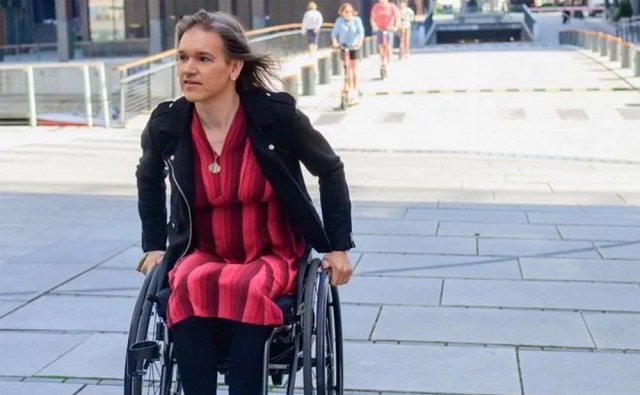Opinion
Transgender ideology has enabled people to ‘identify’ as amputees

Jørund ‘Viktoria’ Alme, a Norwegian man who believes he is a paralyzed woman
From LifeSiteNews
Those who challenge the view that a person can identify as an amputee despite being healthy must also challenge the assertion that one can simply identify as the opposite sex.
Almost ten years ago, I wrote a column in this space on the phenomenon of the so-called “transabled” – people who identify as amputees or suffer from a mental illness that causes them to loathe one of their healthy limbs. In 2022, a high-profile (alleged) example of this emerged when a 53-year-old healthy, non-disabled Norwegian man began identifying as a woman paralyzed from the waist down and took to a wheelchair to give media interviews.
Those who found his claims to be somewhat suspect were in a bit of a bind – which of his assertions, after all, is more ridiculous – that he is a woman, or that he is paralyzed? Our culture has accepted that he can claim to be a woman, and that we must all nod solemnly in response. “How brave of her,” we must all say in unison as his loyal wife pushes him away from the cameras in his wheelchair. “No, not the wife. The other one.”
A grimmer but no less disturbing profile was published recently by the National Post titled “Quebec man has two healthy fingers amputated to relieve ‘body integrity dysphoria.’” It’s a sad story; the young man said he had “intrusive thoughts about his left hand’s fourth and fifth fingers, the sensation they weren’t his, that they didn’t belong to his body” since he was a child and would even have nightmares about them. He fantasized about cutting them off himself. From the Post:
Instead, a surgeon at his local hospital agreed to an elective amputation in what is being called the first described case of ‘digits amputation’ for body integrity dysphoria, or BID, a rare and complex condition characterized by an intense desire to amputate a perfectly healthy body part, such as an arm or a leg. The Quebec case involved an ambidextrous 20-year-old whose attempts at ‘non-invasive’ relief, including cognitive behavioural therapy, Prozac-like antidepressants and exposure therapy, only increased his distress.
What is significant about this case is the way it was described by Dr. Nadia Nadeau of the department of psychiatry at Université Laval in a case study published in the journal Clinical Case Reports. Nadeau describes the young man’s mental and emotional distress, and notes that this distress apparently ceased after the “elective amputation” and that “he was able to pursue the life he envisioned as a complete human being without those two fingers bothering him.” One month post surgery, he had no regrets.
The particularly significant conclusion came towards the end of the report. According to Nadeau: “He is now living a life free from distressing preoccupations about his fingers, with all his symptoms related to BID resolved. The amputation enabled him to live in alignment with his perceived identity.” This, of course, is precisely the argument used by transgender activists making the case for sex change surgeries, cross-sex hormones, and puberty blockers – that these “treatments” will help the recipient “live in alignment with his perceived identity.” Although they wouldn’t call it a “perceived” identity – they’d call it his real identity. This perceived identity, however, was considered real enough that a surgeon removed two of his fingers.
The justifications for these “treatments” that include bodily mutilation are similar, as well. The Post noted that “Nadeau’s patient, after doing some research, ‘related his condition to gender dysphoria’… People with BID often feel their physical body doesn’t align with the image of the body they have in their minds.”
Furthermore, although “cutting off healthy, functioning body parts for psychological distress raises ethical concerns, BID sufferers sometimes resort to self-mutilation or ‘black-market’ amputations, risking their lives.”
A similar argument is made for “transgender care”: if extreme medical intervention does make the mentally ill person’s body resemble the image of reality in their minds, they might harm themselves. That’s the catch-22, of course. Isn’t surgical mutilation also harm, by definition? Not if you redefine it – that’s why trans activists no longer refer to sex change surgeries, but “gender-affirming care.” According to Nadeau: “Recognizing and addressing the unique needs of (BID) patients can lead to a future where they can live with more dignity, respect and optimal well-being.”
Who can disagree with a campaign to increase understanding and dignity for the mentally ill? I wonder, however, what the limiting principle is here. If a young man who believes himself to be a woman can get himself legally castrated by a surgeon, why can’t a man who believes he is an amputee have a leg removed? Or an arm? If we have accepted that people’s self-perceptions are more important than actual reality, where does it stop?
International
U.S. birth rate hit record low last year, signaling surge in childlessness

From LifeSiteNews
As data analyst Stephen Shaw has documented in his film ‘Birthgap,’ declining birth rates in the U.S. and around the world are being driven by an ‘explosion’ in women choosing not to have children.
The U.S. birth rate hit a record low last year of 1.62 births per woman according to data from the Centers for Disease Control and Prevention (CDC), part of a worldwide trend of declining birth rates that have been shown to stem from rising childlessness.
The U.S. has had birth rates mostly below replacement level since 1972, according to United Nations (UN) data, with a minor brief respite from 2006 to 2007, when birth rates were just at replacement level. Birth rates hovered near replacement level from about 1989 to its recent peak of 2.11 births per woman in 2007. Since then, the birth rate has steadily declined.

The new CDC data shows that the birth rate for women ages 20 to 24 has seen a particularly steep decline of 47% since 2007. From 2022 to 2023 alone, the number of births for this age group dropped 4%.
As data analyst Stephen Shaw has documented in his film “Birthgap,” declining birth rates not just in the U.S. but around the world are being driven not by smaller family sizes but by an “explosion” in childlessness.
By comparing statistics on first-time mothers and the number of children they go on to have with national fertility rates, Shaw found that childlessness rates skyrocketed within only a few years in many countries.
For example, in Japan in 1974, one in 20 women were childless. By 1977, this ratio was one in four, and by 1990, it had reached one in three, a statistic that held in 2020. While Shaw doesn’t give specific numbers for most countries, he shares that most have become, like Italy and Japan, “childless nations,” where one-third or more people will become “childless for life.”
And according to the Pew Research Center, by 2010, “Nearly one-in-five American women end(ed) her childbearing years without having borne a child, compared with one-in-10 in the 1970s.” As of 2018, 41% of women between the ages of 25 and 44 were single and childless, and that number is projected to spike to a whopping 45% by 2030.
Just as remarkable as this trend is the finding in a Dutch meta-analysis, cited by author Jody Day in Shaw’s “Birthgap” film, and using data from the early 2000s, that only 10 percent of such women are childless “by choice,” and another 10 percent are childless due to “known” medical reasons, including infertility.
Institute for Family Studies (IFS) confirmed in December 2022 that the majority of childless women actually desire children. Thus, as Shaw summed up in his film, the main driver of childless women around the world now is failing to “find the right partner at the right time.”
Shaw highlighted what appear to be contributing factors: childbearing is delayed until a woman’s fertility window closes; women tend to want to settle with men at least as educated as they are, and everywhere, significantly more women are attending college than men; there are “too many options;” a number of young men are staying at home playing video games instead of pursuing women (or have given up on that).
Many speculate that increased pornography use and addiction is disincentivizing young men’s pursuit of women, and that overuse of technology is leading many young men and women to live isolated from each other.
The increasing secularization of society may also lead to growing numbers of childless women (and men) through a whole slew of hard-to-quantify factors, including by diminishing young people’s sense of purpose and happiness, and depriving them of character formation and a meaningful, effective way to select a mate.
Commentators such as Elon Musk have warned that if global birth rates continue to decline at their current projected rates, “human civilization will end.”
Economy
Today’s federal government—massive spending growth and epic betting

From the Fraser Institute
One can legitimately ask whether the federal government has simply grown too big, complex and unwieldy to be managed at all
The Trudeau government’s 2024 budget landed with a thud, evoking little enthusiasm and drawing spirited criticism from business leaders, investors, provincial premiers and (of course) the opposition parties. Several elements of the budget have garnered outsized attention, notably the pledge to run endless deficits, the imposition of higher capital gains taxes, and various new programs and policy initiatives intended to address Canada’s housing crisis.
But the budget includes a few eye-catching data points that have been downplayed in the subsequent political and media commentary.
One is the sheer size of the government. The just-completed fiscal year marked a milestone, as Ottawa’s total spending reached half a trillion dollars ($498 billion, to be exact, excluding “actuarial losses”). According to the budget, the government will spend $95 billion more in 2024-25 than it planned only three years ago, underscoring the torrid pace of spending growth under Prime Minister Trudeau.
One can legitimately ask whether the federal government has simply grown too big, complex and unwieldy to be managed at all, even if we assume the politicians in charge truly care about sound management. How many parliamentarians—or even cabinet ministers—have a sufficient understanding of the sprawling federal apparatus to provide meaningful oversight of the vast sums Ottawa is now spending?
The ArriveCAN scandal and chronic problems with defence procurement are well-known, but how good a job is the government doing with routine expenditure programs and the delivery of services to Canadians? The auditor general and the Parliamentary Budget Officer provide useful insights on these questions, but only in a selective way. Parliament itself tends to focus on things other than financial oversight, such as the daily theatre of Question Period and other topics conducive to quick hits on social media. Parliament isn’t particularly effective at holding the government to account for its overall expenditures, even though that ranks among its most important responsibilities.
A second data point from the budget concerns the fast-rising price tag for what the federal government classifies as “elderly benefits.” Consisting mainly of Old Age Security and the Guaranteed Income Supplement, these programs are set to absorb $81 billion of federal tax dollars this year and $90 billion by 2026-27, compared to $69 billion just two years ago. Ottawa now spends substantially more on income transfers to seniors than it collects in GST revenues. At some point, a future government may find it necessary to reform elderly benefit programs to slow the relentless cost escalation.
Finally, the budget provides additional details on the Trudeau government’s epic bet that massive taxpayer-financed subsidies will kickstart the establishment of a major, commercially successful battery and electric vehicle manufacturing “supply chain” in Canada. The government pledges to allocate “over $160 billion” to pay for its net-zero economic plan, including $93 billion in subsidies and incentives for battery, EV and other “clean” industries through 2034-35. This spending, the government insists, will “crowd in more private investment, securing Canada’s leadership” in the clean economy.
To say this is a high-risk industrial development strategy is an understatement. Canada is grappling with an economy-wide crisis of lagging business investment and stagnant productivity. Faced with this, the government has chosen to direct hitherto unimaginable sums to support industries that make up a relatively small slice of the economy. Even if the plan succeeds, it won’t do much to address the bigger problems of weak private-sector investment and slumping productivity growth.
Author:
-

 Uncategorized1 day ago
Uncategorized1 day agoMaking Alberta a geothermal energy leader
-

 COVID-192 days ago
COVID-192 days agoPeckford: Hallelujah! Supreme Court of Canada to hear Newfoundland and Labrador charter case
-

 Alberta2 days ago
Alberta2 days agoThree Calgary massage parlours linked to human trafficking investigation
-

 Alberta1 day ago
Alberta1 day agoAlberta’s vision for passenger rail
-

 Alberta2 days ago
Alberta2 days agoCanada’s postal service refuses to help with Trudeau’s gun ban buyback program: report
-

 COVID-191 day ago
COVID-191 day agoStates move to oppose WHO’s ‘pandemic treaty,’ assert states’ rights
-

 Business1 day ago
Business1 day agoParliamentary Budget Officer forecasts bigger deficits for years to come
-

 Addictions1 day ago
Addictions1 day agoMust Watch: Addiction worker estimates 90% of “safer supply” drugs resold on black market









